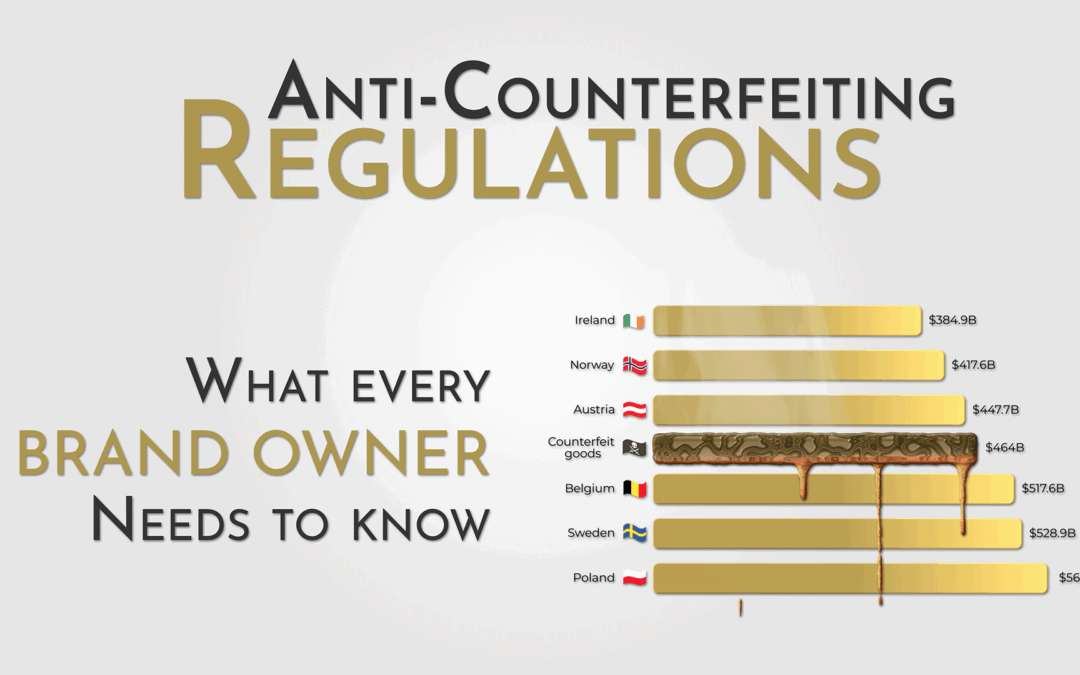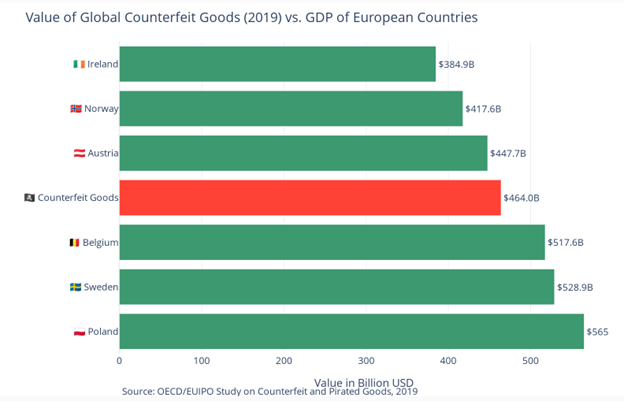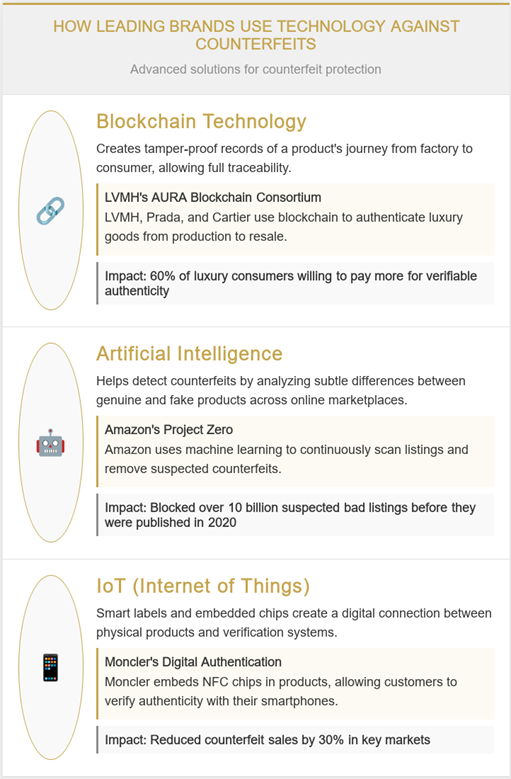The global counterfeit market reached a staggering $464 billion in 2019—larger than Austria’s entire economy. This massive shadow industry threatens brand value, consumer safety, and revenue. Businesses should get ready to fight back against this threat.
Counterfeit products represent a bigger problem than what it may seem like. According to the study Global Trade in Fakes run by EUIPO (European Union Intellectual Property Office) and OECD, counterfeits in 2019 reached a value of $464 billion.
That is 2.5% of global trade.
Take a look at this graph to put things in perspective:
If counterfeit goods were a national economy, they would be worth more than Austria’s GDP.
The problem is two-fold for business owners.
The first, more surface level one, is the lost revenue. A consumer who buys a counterfeit means a lost sale.
The second one, however, is the more problematic one. Counterfeit products do not undergo the same quality control processes as authentic items. They often contain substandard materials, violate safety regulations, and lack proper testing and certification.
When a product fails early — or worse, causes injury — consumers who don’t know better will blame your brand.
We met a lot of brand owners who thought they were safe from counterfeiting. Many discover the problem only after customer complaints start flooding in or when sales mysteriously decline in certain markets. By then, significant damage to brand reputation has already occurred.
This is where anti-counterfeiting regulations become crucial. Across the globe, governments and international bodies have developed complex legal frameworks to combat this issue. Navigating these regulations can be challenging for even the most diligent brand owners.
In this comprehensive guide, you will learn how institutions enforce these measures, and how you can follow them.
Overview of Anti-Counterfeiting Regulations
Anti-counterfeiting regulations are legal frameworks with the goal to protect intellectual property rights and prevent the production, distribution, and sale of counterfeit goods.
These regulations encompass various legal instruments.
Examples include:
- Trademark laws
- Copyright provisions
- Patents
These regulations offer essential business protections to brand owners.
Effective anti-counterfeiting regulations:
- Preserve revenue streams and competitive advantage by preventing unauthorized competitors
- Protect brand reputation and consumer safety by ensuring quality products reach the market
- Provide legal recourse when infringement occurs
In a world without robust regulations, brands would have to fight counterfeiters themselves. That would mean diverting resources from other areas. The result: ballooning costs for producers and consumers.
The economic consequences of counterfeiting extend beyond individual brand losses. Counterfeit products create unfair market competition. They reduce tax revenues. And, they often fund organized crime networks.
A 2016 report by BASCAP and INTA projected that by 2022, counterfeit goods would reach $1.90-$2.81 trillion globally, with wider impacts including:
- Displacement of legitimate economic activity: $980-$1244 billion
- Fiscal losses to governments: $199-$270 billion
Most alarming is the estimated loss of 4.2-5.4 million jobs globally due to counterfeiting.
Evolution of Anti-Counterfeiting Measures
As technology evolved, so have ways to counterfeit and the regulations to combat them.
The Paris Convention (1883) created the first international IP protection framework, while the Madrid Protocol (1989) and TRIPS Agreement (1994) established global standards.
E-commerce growth in the 2000s triggered new regulations for online counterfeiting, including enhanced border controls.
Today’s anti-counterfeiting approaches combine legal frameworks with technological solutions like blockchain, AI systems, and authentication methods, though regional enforcement differences persist.Key Legal Frameworks & Regulations
To protect your brand from counterfeits, you need to understand the main anti-counterfeiting laws in different regions.
North America
In the United States, the main law is the Lanham Act, which lets brand owners sue counterfeiters.
For serious cases, the Stop Counterfeiting in Manufactured Goods Act can send counterfeiters to prison for up to 10 years and fine them up to $2 million.
Canada uses the Combating Counterfeit Products Act to stop fake goods at the border and punish commercial counterfeiters.
Europe
The EU Enforcement Directive makes sure all member countries handle counterfeiting cases in similar ways.
EU Regulation 608/2013 lets customs officers stop suspected fake goods at the border without waiting for a court order.
For medicine, the EU Falsified Medicines Directive requires special packaging features to prevent counterfeits.
Last, for an increasingly digital world, the EU has devised the Digital Services Act (DSA), which entered into force in November 2022 with mandatory compliance for large platforms in 2023.
The DSA establishes stricter liability for online marketplaces regarding counterfeit goods. The DSA requires platforms to verify seller identities and respond promptly to infringement notices, providing brand owners with stronger tools to combat online counterfeiting.
Major European countries also have their own national measures:
- Germany uses its Trademark Act (MarkenG) with specialized IP courts
- France has some of the strongest penalties through its Intellectual Property Code, with fines up to €300,000
- Italy takes a tough stance with its Anti-Counterfeiting System and dedicated police unit
- Spain uses its Trademark Law and Criminal Code to fight counterfeits, with specialized courts for IP cases
- Since Brexit, the UK returned to its Trade Marks Act 1994
The UK also has strong border protection through Customs Enforcement of Intellectual Property Rights.
Asia & Rest of the World
China has gotten tougher on counterfeiters. Its revised Trademark Law, following the 2019 amendment, can make counterfeiters pay up to five times the damages they caused.
India uses the Trademarks Act of 1999 to fight counterfeits, but enforcement can be slow and difficult.
Brazil’s Industrial Property Law can put counterfeiters in prison for up to five years.
International Agreements
The most important global agreement is TRIPS (Trade-Related Aspects of Intellectual Property Rights), which sets minimum standards for all World Trade Organization members.
The Madrid System helps brand owners register their trademarks in many countries at once.
Despite these laws, stopping counterfeiters remains difficult because they often operate across multiple countries, taking advantage of differences in legal systems.
The Intersection of Law and Technology
Two forces protect your brand from counterfeiters:
- Laws frameworks that give you the authority to take action
- Technology solutions you put in place to detect and prevent fakes
Legal protections establish your rights and provide enforcement mechanisms.
Technology offers immediate protection where laws cannot.
The challenge comes from the fact that technology evolves faster than legislation. This creates gaps that counterfeiters exploit, especially in digital marketplaces.
Yet laws also provide the foundation for technological evolution.
Here’s how specific regulations drive technological solutions across different aspects of brand protection:
- Supply Chain Transparency: Regulations like the EU’s Falsified Medicines Directive require complete product traceability. Blockchain provides the immutable record-keeping needed, while physical authentication technologies verify that products match their digital records.
- Border Protection: Customs officials rely on technologies like smartphone verification apps to make quick, accurate judgments when enforcing anti-counterfeiting laws, preventing both counterfeits and unnecessary delays.
- Online Marketplaces: As legislation increasingly holds e-commerce platforms accountable for counterfeit sales, AI-powered monitoring combined with authentication methods helps platforms meet legal obligations.
- Evidence Collection: Anti-counterfeiting lawsuits require conclusive evidence. Technologies like secured QR codes provide court-admissible authentication records that satisfy legal standards across jurisdictions.
- Consumer Safety: Product safety regulations drive the adoption of layered security approaches, combining consumer-verifiable features with advanced covert technologies.
But, despite progress, challenges remain:
- Regulatory lag behind technological advancement
- Vague, technology-neutral legal language
- Inconsistent requirements across jurisdictions
- Limited enforcement expertise
- Disconnect between digital records and physical authentication
Forward-thinking brands implement multi-layered protection strategies that combine digital and physical verification, creating comprehensive security even when regulations haven’t caught up to the latest threats.
Practical Steps for Brand Owners
We’ve been using the term fighting counterfeits a lot. In the real world, though, it’s not really a fight. It’s more of a constant chase where counterfeiters find a new way to do their job and you scramble to cover it.
Start by identifying your most vulnerable products and markets. Which items generate the most profit? These are likely targets for counterfeiters. Document your authentic products thoroughly, from manufacturing specifications to packaging details.
Register your intellectual property rights in every market where you do business. Different jurisdictions need different filings. This foundation gives you legal standing when violations occur.
Work proactively with customs authorities. Help them by filing recordations to support officials in the identification of counterfeits at the border.
Choose technology partners whose solutions integrate seamlessly with your products. Covert features like Cryptoglyph (invisible patterns in varnish) often provide stronger protection than easily copied overt features like holograms.
Here’s how some brands are using the latest tech to protect their image
For products with QR codes or barcodes that need both authentication and tracking capabilities, Secured QR code technology embeds invisible security features directly into these codes without affecting their scanability.
Establish a monitoring routine that combines automated online marketplace scanning with physical market sampling. Train your team to spot inconsistencies in suspected counterfeits.
When counterfeits appear, respond quickly. Swift action not only stops individual violations but signals to counterfeiters that your brand is well-protected and not worth the risk.
Anti-counterfeit resources
The International AntiCounterfeiting Coalition offers guidance and resources against counterfeits.
For industry-specific guidance, look to the Pharmaceutical Security Institute or the Automotive Anti-Counterfeiting Council.
Government customs agencies maintain resources for brand protection — U.S. Customs and Border Protection and the EU Observatory stand ready to assist.
You’re not alone in this fight.
Future Trends & Predictions
Regulators play a game of whac-a-mole with counterfeiters. They probably will until the end of times.
Understanding emerging trends can help brand owners prepare for tomorrow’s challenges.
First, expect a global push toward harmonization of anti-counterfeiting laws. International bodies are working to create more consistent enforcement standards across borders.
Lawmakers are keeping an extra eye on e-commerce platforms. Take the EU’s Digital Services Act and similar legislation worldwide. These laws are establishing stricter liability for online marketplaces that fail to verify seller identities or respond promptly to infringement notices.
We’re also seeing a shift toward greater transparency requirements in supply chains. If you’ve worked in pharmaceutics you are familiar with the track-and-trace systems it uses. Similar systems are now starting to become commonplace in other industries. Brands are increasingly required to document product journeys from manufacturing to consumer.
Penalties for counterfeiting continue to increase in severity. Many jurisdictions around the world treat organized counterfeiting operations as serious criminal enterprises.
Several technologies are reshaping the anti-counterfeiting landscape:
- Blockchain technology creates immutable records of a product’s journey through the supply chain
- Artificial intelligence enables automated scanning of online marketplaces and sophisticated analysis of product images
- Invisible authentication features like AlpVision’s Cryptoglyph create microscopic holes in the varnish layer of packaging that are invisible to the naked eye but verifiable with smartphones
- Molecular and DNA-based tagging allows authentication at scale by embedding unique identifiers into product materials
Selecting the right mix of these technologies for your specific products and supply chain is crucial. AlpVision’s comprehensive whitepaper on selecting anti-counterfeiting technologies provides a practical framework to guide your decision-making process.
The more protection technologies you use, the better you safeguard your products, consumers, and reputation in tomorrow’s marketplace.
Conclusion
Counterfeit poses a serious threat to your brand. Lost sales are at best a mild annoyance. But a consumer losing trust in your brand, which took you years to build, has much deeper implications.
Plus, the web of anti-counterfeiting regulations across the globe can be hard to follow.
That said, understanding these regulations and complying with them makes your brand much more robust.
And as regulations evolve toward greater harmonization and accountability, technologies like Cryptoglyph offer new ways to stay ahead.
Effective brand protection isn’t a one-time fix but an ongoing effort. The cost of doing nothing? Damaged trust, lost revenue, and potential safety incidents.
Your brand took years to build. Don’t let counterfeiters steal it in a day. Take the first step toward comprehensive protection by contacting us today. Our team will help you identify your most vulnerable products and develop a customized protection strategy that aligns with global regulations.
Contact Us



